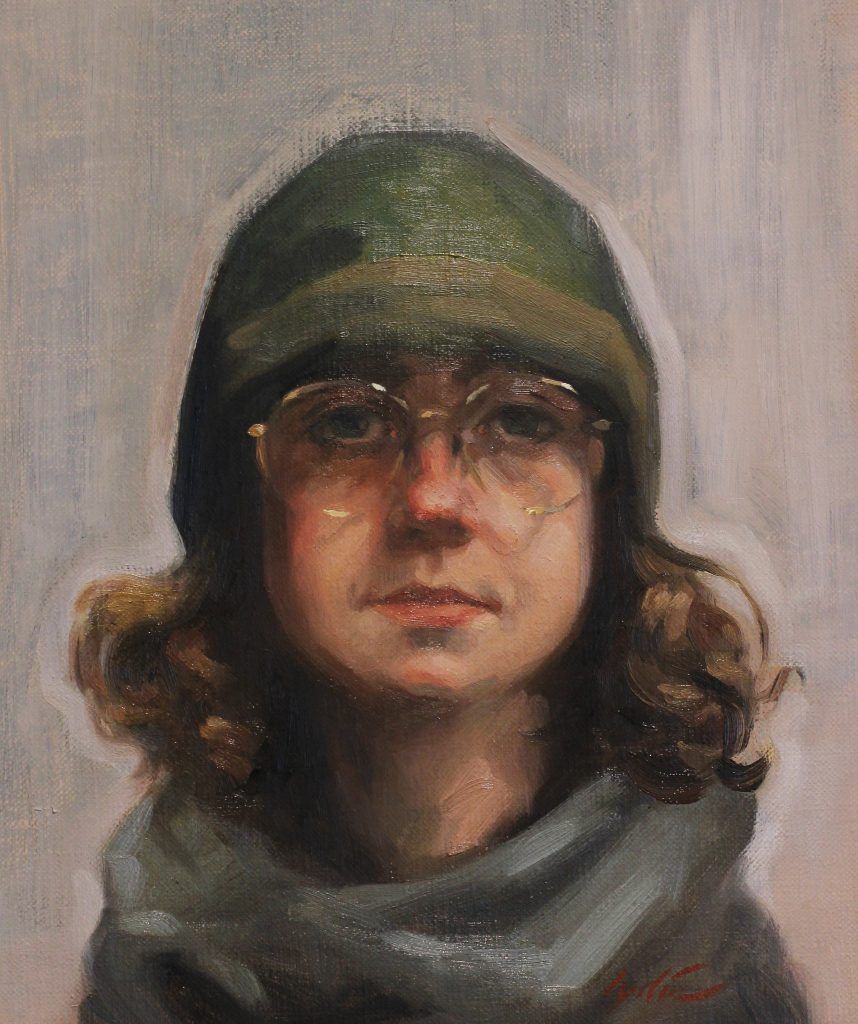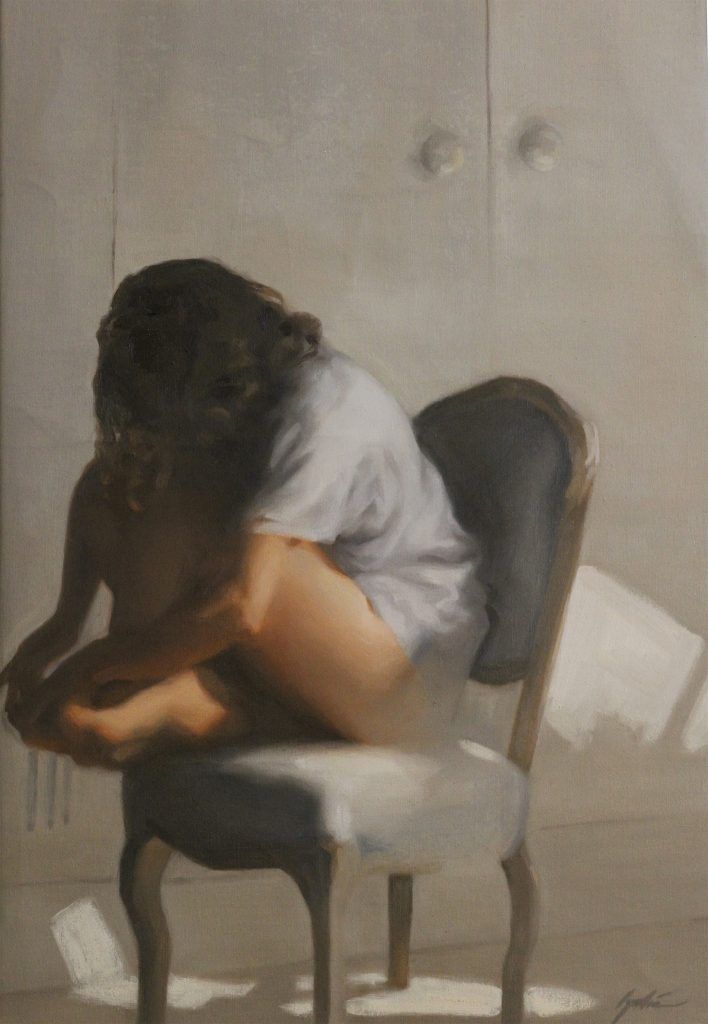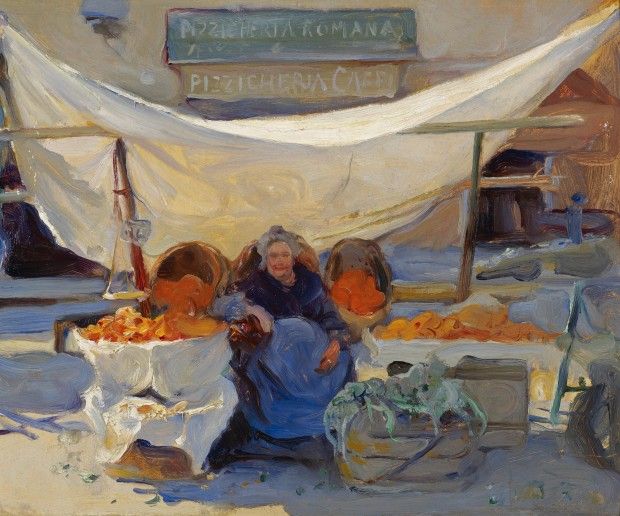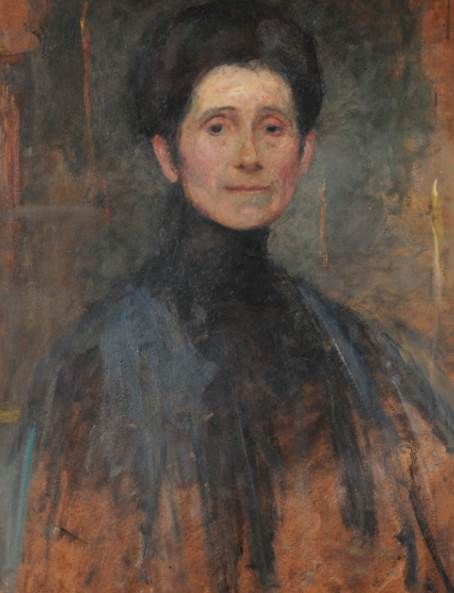Lydia Cecil - Artist Spotlight
Tuesday 7 November, 2023
There’s something about Lydia Cecil’s portraits that’s arresting; often cinematic. Sometimes, her subjects stare out of the frame – ‘Richard’, book on lap, mid-explanation - willing you to know something. In others – ‘Making a Point’ – you want to flick back and forth to the previous/next freeze-frame. To turn the volume up. What point? What is this woman talking about so animatedly?
‘It’s fundamentally human nature to want to portray a person in paint,’ Lydia Cecil says.
‘I love talking to my sitters. You just ask one or two questions about their life, and they essentially talk to you for the next few hours.
‘I like that: hearing a monologue of people’s lives. It’s almost like being a hairdresser. People feel they can talk more freely when they’re sitting for their portrait. When you’re not so directly face to face.’
There’s humour, too. A self-portrait – nose aglow with cold.

A recent one of Lydia sitting in a chair, picking her toenails: ‘Because people do that!’
Ed, pensive hands to face, having an ‘Existential Crisis’. ‘A bit of a joke. I know Ed, and we were having deep discussions about life.’
(Funny, yes; but also a fascinating moment (millisecond?) to choose; one that draws the viewer in. A glimpse, perhaps, of a man experiencing a moment that will change his life… or maybe simply a precursor to thinking about lunch.)
***********
I’m picturing Lydia Cecil as a child surrounded by portraits of illustrious ancestors: grand oils - stiff snow-white collars and yellow-feathered hats - lining a panelled long gallery ideal for exercise in inclement weather.
And maybe – my imagination runs on – here could be found the seeds of Lydia’s own flowering as a portraitist.
But not so; not quite so at all.
‘Certainly at my grandparents’ house, yes: there were family portraits. Less so where we grew up,’ she reflects.
Instead, her memories are wrapped around an expansive kitchen table, cleared in the evening for pencils and paints to be spread out. Her mum – the artist Katie Rockley – started a Hampshire art school with friend Christian de Ferranti when Lydia was 10.
‘It was a time when both my siblings were at boarding school; there was one year where I was essentially an only child, which was great… though I do love my siblings!
‘Dad was working a lot, so evenings it was just me and mum, sitting at the kitchen table, playing music very loudly. And she would teach me how to paint.’
Music?
She laughs. ‘I seem to remember the Blues Brothers’ soundtrack; a lot of Fleetwood Mac; Supertramp was a big one.
‘We’d have the dogs with us – we’re very much an animal-oriented family; we were often painting pictures of our pet chickens.’
It perfectly suited a child who preferred being outdoors with animals to other company; who could sit quietly for hours with just a pencil, completely absorbed.
Yet, when it came to choices, aged 18, art school wasn’t her inclination: ‘I was always more drawn to places like Raw Umber that teach you how to draw and how to paint. Art school, at the time, had a reputation of not having direct tuition.’
History was a subject she loved: not the history of her ancestors – the redoubtable William Cecil, advisor to Elizabeth I, and two prime ministers amongst them.
‘The Cecils have had a reputation for dominating politics,’ she agrees, dryly, ‘though I never particularly wanted to go down the route of family history.
‘I liked 20th century history because it was so direct and informs how we live at the moment.’
Four years at Edinburgh University followed. And, yet, her mind kept returning to art. She flirted with the idea of art school in Florence: Charles Cecil; the Florence Academy of Art… But the commitment (money, time, distance) was huge.
‘I remember sitting with my dad and saying, ‘I don’t know what I’m going to do; what kind of a living I want to go down with my history degree.’
‘And he said, ‘I thought you were going to become an artist?’
‘I went, ‘Oh, OK. If you thought that, then I’ll do that then!’’
Which is how she came to enrol at LARA, the London Atelier of Representational Art.
************

As we chat – by Zoom – Lydia Tanti Burló (her married name) is at home in Malta. She and her husband, Seb Tanti Burló – the highly respected Maltese artist and political cartoonist – divide their time between England, and Siggiewi, one of the beautiful rural spots on the main island.
I think to myself how different must be the environments in which she lives and has lived; and how that must inform her work. The stunning Dorset countryside, housing the family seat where her parents now live.
London, where she studied for two years, ‘Five days a week, full-time: I loved it. Working weekends as well to try to start building up a client-base of commissions. At that time, it was a lot of people’s dogs!’
London again, where she and Seb are now mainly based.
And, yes, let’s talk about Malta: two thousand miles from where she grew up; a million miles politically (maybe). Here, the world is smaller; closer to the bone. There are the politics of deceit; of violent self-interest. The erosion of an idyllic, historic environment, ground down by bulldozers and speculators.
‘Maybe it is just because it’s such a small country that it seems so obvious: we face similar problems in the UK. But also, here, my husband and his family and friends are very politically involved. They don’t have much choice – they see it. They see it crumbling under corruption and environmental catastrophe.
‘So it’s very difficult not to be involved.’
As we speak, Seb has an exhibition in the town of Sliema that combines nostalgia with a devastating critique of what the country is becoming.
‘People have respect for him as one of the few artists who feels he has the freedom to criticise Malta in a way that a lot of people here don’t.’
Seb grew up with the sons of Daphne Caruana Galizia, the anti-corruption journalist assassinated by a car bomb in 2017. ‘They were almost like his brothers, so Daphne’s assassination has informed so much of his life here.
‘Seb has always been very vocal about the uglier sides of Malta. That definitely comes through a lot in his work; and it’s something I started to pick up on as well.’
During lockdown, the two of them were marooned in a flat in Xaghra, on the Maltese island of Gozo, overlooking the Marsalforn Valley: rocky slopes, lush bulrush, colourful painted frog. It was a time of worry about the family back in the UK. But it was also a return to that kitchen table.
‘For me, [that aspect] was great – perhaps back to this idea that I do love just being locked away, doing nothing but painting. Now, if there’s a time where I’ve got a lot of things on and it’s very busy, I get really angsty: I need to have a day of nothing else but painting.’
While Seb was working on big landscapes and interior scenes, Lydia was mostly doing portraits and figurative work.
Such as ‘Don’t judge…’, featuring a large man, Covid mask pulled under chin.
It’s striking; and it’s an admonishment.
Perhaps lockdown, and being in one place with time to study at close hand what was going on, gave a different emotion to her work? Perhaps even an anger?
‘Possibly,’ she says, though she’s long known about the problems the island country faces.
It was more, she says, about giving status to the ordinary people of Gozo; about giving status to everyday moments, too. Using that status to make us look afresh at life.
‘I do like the ordinary side. Particularly, at the moment, I want to concentrate on women. I find misogyny in both countries… Certainly, the misogyny that Daphne faced was unreal.
‘But I like those ordinary moments; finding a bit of normality; humanising people again when they get dehumanised over various forums.’
She’s recently starting exploring the way women are portrayed in art: ‘And I’ve been doing that a lot more with my figurative work. In a broad sense, I’ve become interested in looking at those moments when women are just themselves. Very everyday moments.
‘Women in art tend to have to be very sexual; very virginal; or some kind of warrior status. Some kind of persona put upon them.
‘Sometimes women are just women. We do ordinary stuff as well, you know!’
And sometimes it’s both. The aforementioned ‘Making a point’ is both a snapshot of the everyday; and a comment on the fact that women – in art and in life – have so often had to struggle to make any point at all.
************
In Lydia Cecil’s Raw Umber classes, she teaches the essentials of anatomy, structure, light.
‘I do love portraits of the 20th century because they have this fundamental academic basis to them; and definitely anatomy: it’s crucial to portraiture for sure, and to figurative arts.’
Using natural light is essential.
‘It contains all of the colour wavelengths; so, when it hits the surface of somebody’s face, it’s bringing out all the potential colours. When it’s artificial light, you might be missing some natural colours.’
Is light different in Malta? Does it affect how we see each other?
‘I think so, yeah.’ She laughs again. ‘When we’re here, we’re mostly red and sweaty…’
And when she teaches chalk and charcoal? Why is that so important?
‘Because painting is just drawing with colour, really. Drawing is always the basis of representational art, which is what I do and which is largely taught at Raw Umber. ‘‘Representational’ essentially means that you’re trying to replicate or represent what you see – not identically, but in a way where what it is is understandable: its form; any characteristics that you want to portray… In a way that is very natural for our eye to digest.
‘So you have things like focal points; and thinking about how your eye travels round a piece. All of this largely comes down to drawing and value and edges.’
Drawing in chalk and charcoal is the gateway to using paint.
‘The relationship between light and dark is really what pulls a piece together in many ways: gives it its structure and form and interpretation.
‘If you get any portrait by a master and put it in black and white, you can see how those values are key to the structure; they really thought about that underneath it as well.
‘That’s why it’s such fun to teach.’
Quick-fire questions:
If you could own one painting…
‘The Orange Seller by De Laszlo. It has everything I love in a painting: gorgeous.’

If you could meet one artist…
‘It does always change but, at the moment, it would be Olga Boznańska, a Polish portrait-painter of the early 20th century. She was incredible – and is kind of getting lost. Ahead of her time; pushing boundaries as a woman: she didn’t get married. Painting was enough. She’d always help the poor, and she had this amazing studio – a really cool artist.’

